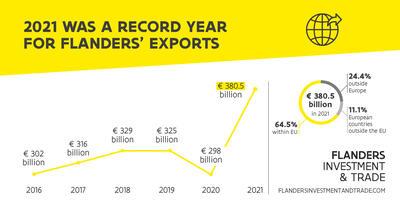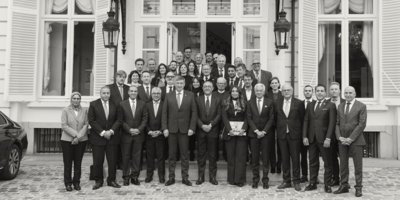
2021 was a record year for Flanders’ exports
Press release – Brussels, 22 March 2022
Summary
-
Last year, Flanders-based companies exported EUR 380.5 billion worth of goods.
-
With a 27.6% increase, exports from Flanders grew more than the EU average.
-
64.5% of exports went to EU member states, 11.1% to European countries outside the EU and 24.4% to the rest of the world.
-
Pharmaceutical, chemical and mineral products were Flanders’ top export goods.
Goods exports from Flanders amounted to EUR 380.5 billion in 2021: an increase of more than a quarter compared to 2020. This figure is over 17% higher than in 2019 – just before the COVID-19 pandemic and Brexit – and 16% higher than the previous record result achieved in 2018. Several reasons can explain this strong growth. For example, there was the economic recovery following the global pandemic. This increased both the demand for and the prices of many products. In addition, the export of COVID-19 vaccines also had a major effect.
The new export record was reached despite a variety of global challenges. Last year, for example, export companies had to deal with disruptions in the production and distribution chains, but also with supply shortages and rising raw material prices.
The fact that Flanders’ exports have emerged from the COVID crisis stronger is an economic boost. As such, the region is – albeit at a stronger rate than average – in line with the upward trend of world trade, which also set a record in 2021 with a turnover of USD 28.5 trillion in exchanged goods and services. Whether this trend will continue in 2022 remains to be seen. The geopolitical and economic impact of the war in Ukraine threatens to profoundly disrupt world trade. The first figures related to its impact on Flanders’ exports and imports are expected from May 2022.
In addition to exports, imports into Flanders also reached a record level in 2021. Their value rose by 34.7% to EUR 378.8 billion. Imports of certain raw materials and components – critical to both production in and exports from Flanders – are also currently unstable.
Flanders’ exports grew faster than those from the Walloon Region (+19.7%) and the Brussels-Capital Region (+2.7%). Last year, Flanders accounted for almost 82% of Belgian exports.
Strong growth at European level
In 2021, Flanders’ exports (+27.6%) grew faster than the European average (+18.9%). The region’s exports rose at a stronger rate than major export-driven countries such as Germany (+14.1%), the Netherlands (+20%), France (+15.8%), Italy (+18.2%) and Spain (20.7%). Flanders’ export growth was also well above the UK’s (+9.5%).
Sectoral export boosters
The rise in exports of pharmaceutical and chemical products – up by 42.4% in 2021– contributed to Flanders’ overall export growth. The central role played by the region in the production and worldwide distribution of COVID-19 vaccines was a real boost for exports. Vaccines alone accounted for a value increase of EUR 25.3 billion. But even without taking these products into account, Flanders’ overall exports would have risen sharply by 19.4%.
Exports of mineral fuels and energy products grew strongly (+76%), driven by rising demand and significant price volatility. Another flagship of Flanders’ exports is and remains mechanical engineering. Last year, this sector accounted for 11.5% more exports than in 2020.
The automotive industry also remains one of Flanders’ most important export sectors, although it has had a difficult year with an increase of only 1.9%. This is partly due to the drop in exports to the UK because of Brexit. However, British demand had been declining for some time. In addition, shortages of components also played a role.
The top 5 export goods from Flanders included (1) pharmaceutical products, (2) chemical products, (3) mineral products, (4) machinery and electronic equipment and (5) transport equipment.
Together, they made up more than half (57.3%) of Flanders’ export value. Plastics landed just outside this top 5.
Most exports went to EU member states
As in previous years, Flanders-based companies mainly exported to other EU countries throughout 2021. In fact, intra-Community trade represented no less than 64.5% of Flanders’ exports. That’s a slight increase compared to 2020, when that share was still at 63%.
More than half (55%) of exports from Flanders are destined to 5 countries, 4 of which have been increasing their demand compared to 2020: Germany (+35%), the Netherlands (+33.9%), France (26.1%), the UK (-2.6%) and the US (+12.4%).
However, exports to Italy (+16.9%), Spain (+28.8%), Poland (+40%) and Japan (+163.5%) also increased strongly. Japan is appearing in the top 10 primarily because it ordered huge quantities of COVID-19 vaccines.
The European markets outside the EU – including post-Brexit UK – accounted for about 11% of exports from Flanders in 2021. Worth noting is the 2.6% drop in exports to the UK, making the country one of Flanders’ few top export destinations to experience a downward trend. The automotive industry, mechanical engineering, the textile sector and horticulture were particularly affected.
About one quarter (24.4%) of exports from Flanders go to continents other than Europe. Overall, the region’s exports demonstrated strong growth in North America (+16.7%), Central America (+30.9%), South America (+30.7%), Asia (+40.5%), the Middle East (+37%), Africa (+51.1%) and Oceania (+49.4%).
Quotes
Press contact Flanders’ Minister-President Jan Jambon
Olivier Van Raemdonck (woordvoerder)
E olivier.vanraemdonck@vlaanderen.be
M +32 470 99 91 01
Press contact Flanders Investment & Trade
Tine Van Valckenborgh
E tine.vanvalckenborgh@fitagency.be
M +32 499 24 60 93





